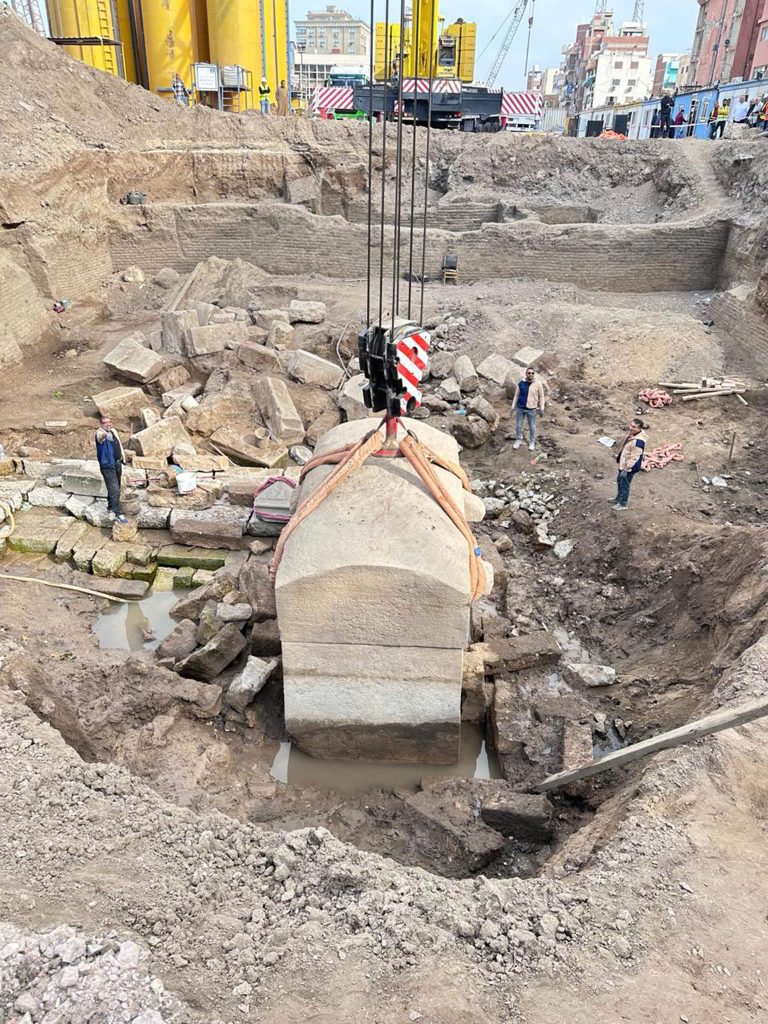In the heart of Egypt’s vast desert, archaeologists have made an astonishing discovery that could forever alter our understanding of ancient civilizations. A monumental 60-ton granite sarcophagus, untouched for thousands of years, has emerged from the sands as a groundbreaking archaeological marvel that challenges everything we thought we knew about the past.
Unlike traditional burial sites, this extraordinary sarcophagus does not serve as the final resting place for human remains. Instead, it stands as an unparalleled time capsule, containing an array of golden artifacts that redefine our perceptions of ancient Egyptian technology and artistry. The craftsmanship displayed in these relics is not only breathtaking but also indicative of a civilization whose advanced skills and understanding of the world were far ahead of their time.

Inside the massive granite container, researchers uncovered a treasure trove of priceless artifacts that defy imagination. Among the discoveries are intricate deity statues that embody the gods revered in ancient Egyptian culture. These statues, adorned with elaborate designs and painstaking details, reveal a level of artistry that surpasses even the highest standards of craftsmanship known to that era. Additionally, finely detailed figurines depicting scenes of everyday life were found, offering a vivid glimpse into the lives of individuals who inhabited this fascinating world. These figurines are more than just art; they are a testament to the rich cultural and social fabric of ancient Egypt.
One of the most remarkable elements of this discovery is a series of inscribed tablets crafted from a mysterious and unprecedented metal. Unlike any material previously associated with ancient Egypt, this unknown metal raises countless questions. Each tablet bears inscriptions in an undeciphered language, representing a tantalizing puzzle for linguists, historians, and archaeologists worldwide. These enigmatic inscriptions hint at the possibility of unknown spiritual practices, uncharted trade routes, or even the existence of entirely forgotten dynasties that played a significant role in shaping the history of the region.
The discovery of the sarcophagus and its contents offers more than just a glimpse into the past—it opens a window to a lost civilization. The exquisite craftsmanship of the artifacts, the mysterious metal, and the undeciphered inscriptions all point to a society that possessed an extraordinary level of knowledge and sophistication. This find challenges the conventional narratives of ancient Egyptian history, forcing scholars to reconsider the technological and artistic capabilities of this remarkable civilization.
The 60-ton granite sarcophagus serves as a portal to a forgotten chapter of human history. It stands as a testament to the complexity and depth of ancient Egyptian culture, illustrating the ingenuity and creativity that defined this enigmatic civilization. As researchers continue to study the artifacts and their implications, new theories are emerging about the origins and evolution of ancient Egyptian society. This discovery underscores the interconnectedness of human history, revealing how much we still have to learn about our shared past.
Among the most captivating aspects of the find is the potential for rewriting historical timelines. The artifacts within the sarcophagus suggest that the civilization responsible for their creation was far more advanced than previously believed. From their sophisticated understanding of metallurgy to their unparalleled artistic expression, the evidence points to a society whose achievements rival those of any modern civilization. This realization challenges historians to reexamine long-held assumptions about the development of ancient cultures and their contributions to human progress.
The inscribed tablets, in particular, hold the promise of unlocking secrets that could reshape our understanding of ancient Egyptian spirituality, governance, and international relations. Scholars are working tirelessly to decode the mysterious language and identify the origins of the unknown metal, hoping to uncover clues about the society that left behind these extraordinary relics. The potential discoveries could shed light on everything from religious beliefs and ceremonial practices to the extent of trade networks and cultural exchanges between ancient Egypt and other civilizations.
As the study of the sarcophagus continues, it becomes increasingly clear that this discovery is one of the most significant archaeological revelations of our time. The artifacts within its granite walls provide a tangible connection to a world that has long been shrouded in mystery. They offer a rare opportunity to explore the ingenuity and resilience of a civilization that thrived in one of the most challenging environments on Earth.
The sarcophagus and its contents also serve as a reminder of the enduring legacy of ancient Egypt. This civilization’s achievements continue to captivate the imagination of people around the world, inspiring awe and admiration for their ability to create works of unparalleled beauty and complexity. The discovery reinforces the importance of preserving and studying our cultural heritage, as each new find adds another piece to the intricate puzzle of human history.
In conclusion, the 60-ton granite sarcophagus unearthed in Egypt’s desert is far more than an archaeological discovery; it is a testament to the ingenuity, creativity, and resilience of a civilization that has left an indelible mark on the world. As researchers delve deeper into the mysteries of the artifacts and inscriptions, they are uncovering new insights into the origins and evolution of ancient Egyptian culture. This remarkable find is a powerful reminder of how much we still have to learn about our human heritage and the stories that continue to shape our understanding of the past. The desert has kept its secrets for thousands of years, but now, piece by piece, we are beginning to unravel the extraordinary story of a civilization that remains one of the greatest marvels of history.





